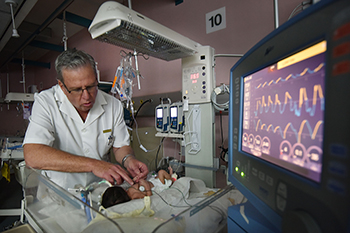
“You grow so fond of them,” Prof André Venter,
Head: Department of Paediatrics and Child Health,
says while doing his rounds with patients.
Prof Venter recently received the award for health professions
from the international organisation, Unashamedly Ethical. |
“You are such a pretty baby,” Prof André Venter, Head: Department of Paediatrics and Child Health at the University of the Free State, whispers to a baby lying stretched out in her neonatal cradle.
He uses his fingertips to free her legs and arms carefully from the monitors and wires attached to her.
“See how much you have grown,” he says, tapping with his finger on her file. 1.2 kg - her weight indicates.
In one of the other children’s wards, he joins a mother sitting with her sick baby. Speaking about the baby’s operation coming up within the next few months, he gives her an encouraging pat on the shoulder.
He visits yet another mother who is practising kangaroo care on her baby, and asks to hold the baby for a while.
“Gosh, you’re so nice and warm, let doctor hold you for a while,” he says, hugging the premature baby to his chest.
Prof Venter greets and thanks the nursing staff at the end of his ward rounds.
“Everything is not always good, but one can try to plan for the future from the challenges,” he says. “One should never concentrate on the immediate problem too much, but lift the morale of those using our services, those providing the services, and those who come here for training.”
It is this kind of passion and outlook that earned Prof Venter an ethical award from the international organisation, Unashamedly Ethical. The award, which was made in the health professions category, recognises doctors for exceptional ethical values and for going the extra mile in alleviating the suffering of humanity.
“I am humbled at being honoured for something I see as my passion and actually take for granted. I am also touched that people from outside noticed and nominated me for this,” he says.
He talks about his young patients again: “I learn so much from them each day. Children are so resistant to negative things. I grow so fond of them that I forget they have to go home some time.”